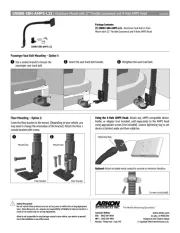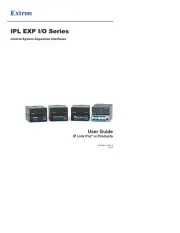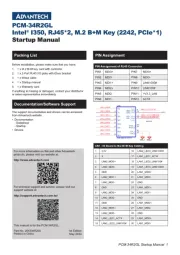Monacor CTG-1Noise Handleiding
Monacor
Niet gecategoriseerd
CTG-1Noise
Bekijk gratis de handleiding van Monacor CTG-1Noise (4 pagina’s), behorend tot de categorie Niet gecategoriseerd. Deze gids werd als nuttig beoordeeld door 61 mensen en kreeg gemiddeld 4.9 sterren uit 31 reviews. Heb je een vraag over Monacor CTG-1Noise of wil je andere gebruikers van dit product iets vragen? Stel een vraag
Pagina 1/4

THE AUDIO COMPANY THE AUDIO COMPANY THE AUDIO COMPANY THE AUDIO COMPANY THE AUDIO COMPANY THE AUDIO COMPANY THE AUDIO COMPANY THE AUDIO COMPANY
CTG-1NOISE Bestell-Nr. • Order No. 0292050
CTG-1SINE Bestell-Nr. • Order No. 0292060
CTG-1WNOISE Bestell-Nr. • Order No. 1000942
Copyright© by MONACOR INTERNATIONAL
All rights reserved
A-1862.99.02.10.2022
MONACOR INTERNATIONAL GmbH & Co. KG
Zum Falsch 36, 28307 Bremen
Germany
Function Tester in XLR Plug
These instructions are intended for users
with basic knowledge in audio technology.
Please read the instructions carefully prior to
operation and keep them for later reference.
1 Applications
Is this situation familiar to you? The microphone
on the stage does not provide any signal to the
front of house and you are the one in charge of
finding the error? Is the error due to the micro‑
phone or the cable? Or to the multicore cable
or the mixer channel? An ohmmeter is currently
not at hand or its battery is almost discharged.
The MONACOR solution: Just connect the
CTG to the microphone cable and activate the
phantom power supply – the tester will then
indicate the error. Three CTG versions are avail‑
able: CTG‑1NOISE with pink‑noise generator,
CTG‑1WNOISE with white‑noise generator and
CTG‑1SINE with 100 Hz sine wave generator.
2 Important Notes
The tester corresponds to all relevant directives
of the EU and is therefore marked with .
The tester corresponds to the relevant UK legisla‑
tion and is therefore marked with .UKCA
•
The tester is suitable for indoor use only. Pro‑
tect it against dripping water, splash water
and high air humidity. The admissible ambient
temperature range is 0 – 40 °C.
•
For cleaning only use a dry, soft cloth; never
use water or chemicals.
•
No guarantee claims for the tester and no
liability for any resulting personal damage or
material damage will be accepted if the tester
is used for other purposes than originally
intended, if it is not correctly connected, or if
it is not repaired in an expert way.
If the tester is to be put out of oper‑
ation definitively, take it to a local recy‑
cling plant for a disposal which is not
harmful to the environment.
3 Operation
1) Mute the audio system.
2) Set the mixer channel where the signal is
not available according to the signal source
(microphone, instrument etc.) and activate
the phantom power supply.
3) Instead of the signal source, connect the
tester to the audio cable.
4) The LED on the tester will indicate the error
detected:
LED Status
Flashes twice Pin 2 of the cable defective
Flashes three times Pin 3 of the cable defective
Does not light up at all
Pin 1 of the cable defective
or phantom power supply not
available
LED Status
Lights up continuously
Generator signal available:
To check, unmute the audio
system; the generator signal
should be audible.
Check the signal source!
4 Specifications
Output signal
CTG‑1NOISE: . . . . . pink noise
CTG‑1WNOISE: . . . white noise
CTG‑1SINE: . . . . . . 100 Hz sine wave
Level: . . . . . . . . . . . approx. 100 V (p‑p)
Connections: . . . . . . XLR, balanced
pin 1 = ground
pin 2 = signal +
pin 3 = signal −
Error indication: . . . . via LED
Power supply: . . . . . . phantom power
9 – 48 V (⎓)
Dimensions: . . . . . . . 19 mm × 74 mm⌀
Weight: . . . . . . . . . . 31 g
Housing: . . . . . . . . . . XLR plug
Subject to technical modification.
Funktionstester im XLR-Stecker
Diese Anleitung richtet sich an Benutzer
mit Grundkenntnissen in der Audiotechnik.
Bitte lesen Sie die Anleitung vor dem Betrieb
gründlich durch und heben Sie sie für ein
späteres Nachlesen auf.
1 Einsatzmöglichkeiten
Kennen Sie die Situation? Das Mikrofon auf der
Bühne gibt kein Signal zum FOH‑Platz und Sie
müssen den Fehler finden. Ist es das Mikrofon
oder das Kabel? Ist es das Multicore oder der
Pultkanal? Ein Ohmmeter ist gerade nicht zur
Hand oder die Batterie darin ist leer.
Die Lösung von MONACOR: Stecken Sie ein‑
fach den CTG an das Mikrofonkabel, schalten
Sie die Phantomspeisung ein und der Tester
zeigt Ihnen den Fehler an. Der CTG ist mit einem
Rosa‑ Rauschen‑Generator (‑1NOISE), einem Wei‑
ßes‑Rauschen‑Generator (‑1WNOISE) oder mit
einem 100‑Hz‑ Sinus‑Generator (‑1SINE) erhält‑
lich.
2 Wichtige Hinweise für den Gebrauch
Der Tester entspricht allen relevanten Richtlinien
der EU und trägt deshalb das ‑Zeichen.
•
Der Tester ist nur zur Verwendung im Innenbe‑
reich geeignet. Schützen Sie ihn vor Tropf‑ und
Spritzwasser sowie hoher Luftfeuchtigkeit. Der
zulässige Einsatztemperaturbereich beträgt
0 – 40 °C.
•
Verwenden Sie zum Reinigen nur ein trocke‑
nes, weiches Tuch, niemals Chemikalien oder
Wasser.
•
Wird der Tester zweckentfremdet, falsch an‑
geschlossen oder nicht fachgerecht repariert,
kann keine Haftung für daraus resultierende
Sach‑ oder Personenschäden und keine Garan‑
tie für den Tester übernommen werden.
Soll der Tester endgültig aus dem Be‑
trieb genommen werden, übergeben
Sie ihn zur umweltgerechten Entsor‑
gung einem örtlichen Recyclingbetrieb.
3 Bedienung
1) Die Audioanlage stummschalten.
2) Den Mischpultkanal, an dem das Signal fehlt,
der Signalquelle (Mikrofon, Instru ment etc.)
entsprechend einstellen und die Phantom‑
speisung einschalten.
3) Anstelle der Signalquelle den Tester an das
Audiokabel anschließen.
4) Die LED am Tester blinkt oder leuchtet ent‑
sprechend dem festgestellten Fehler:
LED Status
blinkt 2 × Kabel am Pin 2 unterbrochen
blinkt 3 × Kabel am Pin 3 unterbrochen
leuchtet gar nicht Kabel am Pin 1 unterbrochen
oder Phantomspannung fehlt
LED Status
leuchtet konstant
Generatorsignal vorhanden:
Zur Kontrolle die Audioanlage
wieder lautschalten; das Gene-
ratorsignal sollte zu hören sein.
Signalquelle überprüfen!
4 Technische Daten
Ausgangsignal
CTG‑1NOISE:. . . . . . Rosa Rauschen
CTG‑1WNOISE:. . . . Weißes Rauschen
CTG‑1SINE: . . . . . . 100‑Hz‑Sinus
Pegel: . . . . . . . . . . . ca. 100 mV (SS)
Anschlüsse: . . . . . . . . XLR, symmetrisch
Pin 1 = Masse
Pin 2 = Signal +
Pin 3 = Signal −
Fehleranzeige: . . . . . . über LED
Stromversorgung: . . . Phantomspeisung
9 – 48 V (⎓)
Abmessungen: . . . . . 19 mm × 74 mm⌀
Gewicht: . . . . . . . . . . 31 g
Gehäuse: . . . . . . . . . XLR‑Stecker
Änderungen vorbehalten.
DeutschEnglish

THE AUDIO COMPANY THE AUDIO COMPANY THE AUDIO COMPANY THE AUDIO COMPANY THE AUDIO COMPANY THE AUDIO COMPANY THE AUDIO COMPANY THE AUDIO COMPANY
Copyright© by MONACOR INTERNATIONAL
All rights reserved
A-1862.99.02.10.2022
MONACOR INTERNATIONAL GmbH & Co. KG
Zum Falsch 36, 28307 Bremen
Germany
Tester delle funzioni
nel connettore XLR
Queste istruzioni sono rivolte agli utenti
con conoscenze base nella tecnica audio. Vi
preghiamo di leggerle attentamente prima
della messa in funzione e ci conservarle per
un uso futuro.
1 Possibilità d’impiego
Conoscete questa situazione? Il microfono sul
palcoscenico non dà nessun segnale al posto
FoH e dovete trovare il difetto. È il microfono o il
cavo? È il multicore o il canale della consolle? Un
ohmmetro non avete a portata di mano oppure
la sua batteria è scarica.
La soluzione di MONACOR: Inserite semplice‑
mente il CTG nel cavo del microfono, attivate
l’alimentazione phantom e il tester vi farà vedere
il difetto. Il CTG è disponibile con un genera‑
tore di rumore rosa (‑1NOISE), rumore bianco
(‑1WNOISE) o con un generatore di tensione
sinusoidale di 100 Hz (‑1SINE).
2 Avvertenze importanti per l’uso
Il tester è conforme a tutte le direttive rilevanti
dell’UE e pertanto porta la sigla .
•
Il tester è previsto solo per l’uso all’interno di
locali. Proteggerlo dall’acqua gocciolante e
dagli spruzzi d’acqua nonché da alta umidità
dell’aria. La temperatura d’esercizio ammessa
è 0 – 40 °C.
•
Per la pulizia usare solo un panno morbido,
asciutto; non impiegare mai acqua o prodotti
chimici.
•
Nel caso d’uso improprio, di collegamenti sba‑
gliati o di riparazione non a regola d’arte del
tester, non si assume nessuna responsabilità
per eventuali danni consequenziali a persone
o a cose e non si assume nessuna garanzia
per il tester.
Se si desidera eliminare il tester defi‑
nitivamente, consegnarlo per lo smal‑
timento ad un’istituzione locale per il
riciclaggio.
3 Funzionamento
1) Mettere in muto l’impianto audio.
2) Impostare il canale del mixer con il segnale
mancante secondo la fonte dei segnali (micro‑
fono, strumento ecc.) e attivare l’alimenta‑
zione phantom.
3) Al posto della fonte dei segnali, collegare il
tester con il cavo audio.
4) Il LED sul tester lampeggia oppure si accende
secondo il difetto trovato:
LED Stato
lampeggia 2 × cavo al pin 2 interrotto
lampeggia 3 × cavo al pin 3 interrotto
non si accende cavo al pin 1 interrotto oppure
alimentazione phantom assente
LED Stato
rimane acceso
segnale del generatore presente:
come controllo rimettere l‘audio
dell‘impianto audio; si dovrebbe
sentire il segnale del generatore.
Controllare la fonte dei segnali!
4 Dati tecnici
Segnale d’uscita
CTG‑1NOISE:. . . . . . rumore rosa
CTG‑1WNOISE:. . . . rumore bianco
CTG‑1SINE: . . . . . . sinusoidale 100 Hz
Livello: . . . . . . . . . . ca. 100 mV (pp)
Contatti: . . . . . . . . . . XLR, bilanciato
pin 1 = massa
pin 2 = segnale +
pin 3 = segnale −
Indicazione difetto: tramite LED . .
Alimentazione: . . . . . alimentazione phantom
9 – 48 V (⎓)
Dimensioni: . . . . . . . . 19 mm × 74 mm⌀
Peso: . . . . . . . . . . . . . 31 g
Corpo: . . . . . . . . . . . connettore XLR
Con riserva di modifiche tecniche.
Testeur de fonctionnement
dansfiche XLR
Cette notice s’adresse aux utilisateurs avec
des connaissances de base en audio. Veuillez
lire la présente notice avec attention avant le
fonctionnement et conservez‑la pour pou‑
voir vous y reporter ultérieurement.
1 Possibilités d’utilisation
Vous connaissez la situation ? Le microphone sur
scène n’émet aucun signal vers le public et vous
devez trouver d’où vient le problème. Est‑ce le
microphone ou le câble ? Est‑ce le multiconduc‑
teurou le canal de la table de mixage? Vous
n’avez pas d’ohmmètre sous la main ou la bat‑
terie est vide.
La solution de MONACOR : branchez tout sim‑
plement le CTG au cordon micro, allumez l’ali‑
mentation fantôme et le testeur indique l’erreur.
Le CTG est disponible avec un générateur de
bruit rose (‑1NOISE), bruit blanc (‑1WNOISE) ou
avec un générateur de 100 Hz sinus (‑1SINE).
2 Conseils importants d’utilisation
Le testeur répond à toutes les directives néces‑
saires de l’Union européenne et porte donc le
symbole .
•
Le testeur n’est conçu que pour une utilisation
en intérieur. Protégez‑le de tout type de pro‑
jections d’eau, des éclaboussures et d’une hu‑
midité élevée de l’air. La plage de température
de fonctionnement autoriséeest de 0 – 40 °C.
•
Pour le nettoyage, utilisez un chiffon doux
et sec, en aucun cas d’eau ou de produits
chimiques.
•
Nous déclinons toute responsabilité en cas de
dommages matériels ou corporels résultants si
le testeur est utilisé dans un but autre que celui
pour lequel il a été conçu, s’il n’est pas cor‑
rectement branché ou s’il n’est pas réparé par
une personne habilitée; de même, la garantie
deviendrait caduque.
Lorsque le testeur est définitivement
retiré du service, vous devez le déposer
dans une usine de recyclage adaptée
pour contribuer à son élimination non
polluante.
CARTONS ET EMBALLAGE
PAPIER À TRIER
3 Utilisation
1) Coupez le son de l’installation audio.
2) Réglez le canal de la table de mixage sur
lequel le signal est absent, en fonction de
la source de signal (micro, instrument ...) et
allumez l’alimentation fantôme.
3) Reliez le testeur au cordon audio à la place de
la source de signal.
4) La LED sur le testeur clignote ou brille selon
l’erreur constatée :
LED Etat
clignote 2 × câble au pin 2 interrompu
clignote 3 × câble au pin 3 interrompu
ne brille pas câble au pin 1 interrompu ou
alimentation fantôme manquante
brille en continu
le signal du général existe : pour
le contrôle, activez le son de
l’installation audio : le signal du
générateur devrait être audible.
Vérifiez la source de signal !
4 Caractéristiques techniques
Signal de sortie
CTG‑1NOISE: . . . . . bruit rose
CTG‑1WNOISE: . . . bruit blanc
CTG‑1SINE: . . . . . . 100 Hz sinus
Niveau: . . . . . . . . . 100 mV (cc) environ
Branchements: . . . . . XLR, symétrique
pin 1 = masse
pin 2 = signal +
pin 3 = signal −
Indication d’erreur: . via LED
Alimentation: . . . . . . alimentation fantôme
9 – 48 V (⎓)
Dimensions: . . . . . . . 19 mm × 74 mm⌀
Poids: . . . . . . . . . . . . 31 g
Corps: . . . . . . . . . . . fiche XLR
Tout droit de modification réservé.
FrançaisItaliano
CTG-1NOISE Référence num. • Codice 0292050
CTG-1SINE Référence num. • Codice 0292060
CTG-1WNOISE Référence num. • Codice 1000942

THE AUDIO COMPANY THE AUDIO COMPANY THE AUDIO COMPANY THE AUDIO COMPANY THE AUDIO COMPANY THE AUDIO COMPANY THE AUDIO COMPANY THE AUDIO COMPANY
Copyright© by MONACOR INTERNATIONAL
All rights reserved
A-1862.99.02.10.2022
MONACOR INTERNATIONAL GmbH & Co. KG
Zum Falsch 36, 28307 Bremen
Germany
CTG-1NOISE N.º de pedido • Numer kat. 0292050
CTG-1SINE N.º de pedido • Numer kat. 0292060
CTG-1WNOISE N.º de pedido • Numer kat. 1000942
Comprobador de funciones en
un conector XLR
Este manual está dirigido a usuarios con
conocimientos básicos en tecnología de
audio. Lea detenidamente las instrucciones
antes de utilizar el producto y consérvelas
para futuras consultas.
1 Posibles usos
¿Se p3-ha encontrado p3-ya en esta situación? Un mi‑
crófono en el escenario no da señal a la posición
FOH y no sabe dónde se encuentra el error. ¿Se
trata del micrófono o del cable? ¿Es el cable
multicore o el canal de la consola? En este mo‑
mento no se dispone de un óhmetro o la pila
está agotada.
La solución de MONACOR: sólo tiene que co‑
nectar el CTG al cable del micrófono, conectar
la alimentación fantasma y el comprobador le
mostrará el error. El CTG está disponible con un
generador de ruido rosa (‑1NOISE), un genera‑
dor de ruido blanco (‑1WNOISE) o con un gene‑
rador sinusoidal de 100 Hz (‑1SINE).
2 Notas importantes para el uso
El comprobador cumple con todas las directi‑
vas pertinentes de la UE y, por lo tanto, lleva la
marca .
•
El comprobador sólo es apto para su uso en
interiores. Protéjalo de gotas y salpicaduras de
agua y de la alta humedad. El rango de tem‑
peratura de funcionamiento admisible es de
0°C a 40°C.
•
Utilice sólo un paño seco y suave para su lim‑
pieza, nunca productos químicos o agua.
•
Si el comprobador se utiliza de forma inco‑
rrecta, se conecta mal o no se repara profesio‑
nalmente, no se aceptará ninguna responsa‑
bilidad por los daños materiales o personales
resultantes y no se ofrecerá ningún tipo de
garantía.
Si el comprobador va a ser retirado del
servicio de forma permanente, entré‑
guelo a una empresa de reciclaje local
para que lo elimine de forma respe‑
tuosa con el medio ambiente.
3 Manejo
1) Silenciar el sistema de audio.
2) Ajuste el canal del mezclador en el que falta la
señal según la fuente de la señal (micrófono,
instrumento, etc.) y conecte la alimentación
fantasma.
3) En lugar de la fuente de señal, conecte el
comprobador al cable de audio.
4) ‑El LED del comprobador parpadea o se en
ciende en función del error detectado:
LED Estado
Parpadea 2 veces Cable interrumpido en el pin 2
Parpadea 3 veces Cable interrumpido en el pin 3
LED Estado
No se enciende
Cable interrumpido en el
pin 1 o falta la alimentación
fantasma
Encendido permanen-
temente
Señal del generador presente:
para verificar, vuelva a
encender el sistema de audio;
la señal del generador debe ser
audible.
Compruebe la fuente de señal.
4 Datos técnicos
Señal de salida
CTG‑1NOISE:. . . . . . Ruido rosa
CTG‑1WNOISE:. . . . Ruido blanco
CTG‑1SINE: . . . . . . sinusoidal de 100 Hz
Nivel: . . . . . . . . . . . aprox. 100mV (pp)
Conexiones: . . . . . . . XLR, balanceado
Pin 1 = tierra
Pin 2 = señal +
Pin 3 = señal −
Indicación de error: mediante LED . .
Alimentación: . . . . . . )fantasma 9 – 48V (⎓
Dimensiones: . . . . . . 19mm × 74mm⌀
Peso: . . . . . . . . . . . . . 31g
Carcasa: . . . . . . . . . . conector XLR
Sujeto a cambios sin previo aviso.
Español
Testery kabli XLR
Niniejsza instrukcja przeznaczona jest dla
instalatorów posiadających podstawową
wiedzę w zakresie systemów audio. Przed
rozpoczęciem użytkowania proszę zapoznać
się z instrukcją, a następnie zachować ją do
wglądu.
1 Zastosowanie
Czy ta sytuacja jest Ci znana? Mikrofon na
scenie, w reżyserce żadnego sygnału i to Ty je‑
steś odpowiedzialny za znalezienie przyczyny?
Wina mikrofonu czy kabla? A może kanału
miksera? Omomierza nie masz pod ręką lub jego
bateria jest prawie rozładowana.
Oto rozwiązanie od MONACOR: Wystarczy
podłączyć tester CTG do kabla mikrofonowego i
włączyć zasilanie phantom – tester sam wskaże
gdzie jest błąd. Dostępne są trzy wersje teste‑
rów: CTG‑1NOISE z generatorem szumu różo‑
wego, CTG‑1WNOISE z generatorem szumu
białego oraz CTG‑1SINE z generatorem fali sinu‑
soidalnej 100 Hz.
2 Środki bezpieczeństwa
Urządzenia spełniają wszystkie wymagania norm
UE, dlatego zostały oznaczone symbolem .
•
Urządzenia przeznaczone są wyłącznie do
zastosowań wewnątrz pomieszczeń. Należy
chronić je przed wodą, dużą wilgotnością
oraz wysoką temperaturą (dopuszczalny za‑
kres 0 – 40 °C).
•
Do czyszczenia obudowy należy używać tylko
suchej, miękkiej ściereczki. Nie stosować wody
lub innych środków chemicznych.
•
Producent ani dostawca nie ponoszą odpo‑
wiedzialności za wynikłe szkody lub utratę
zdrowia użytkownika, jeśli urządzenie było
używane niezgodnie z przeznaczeniem, zo‑
stało podłączone niewłaściwie lub poddane
nieautoryzowanej naprawie.
Po całkowitym zakończeniu eks‑
ploatacji, należy oddać urządze‑
nie do punktu recyklingu, aby nie
zaśmiecać środowiska.
3 Obsługa
1) Wyciszyć system audio.
2) Ustawić odpowiedni kanał miksera zgodnie
z rodzajem podłączanego źródła (mikrofon,
instrument itp.) i aktywować zasilanie phan‑
tom.
3) ‑Zamiast źródła sygnału, do kabla audio pod
łączyć tester.
4) ‑Wskaźnik diodowy na testerze wskaże przy
czynę błędu:
Dioda Status
Miga dwa razy Pin 2 odłączony
Miga trzy razy Pin 3 odłączony
Nie zapala się w ogóle Pin 1 odłączony lub zasilanie
phantom niedostępne
Dioda Status
Świeci ciągle
Generator sygnału: Wyłączyć
wyciszenie systemu audio;
sygnał z generatora powinien
być słyszalny.
Sprawdzić działanie źródła
sygnału!
4 Specyfikacja
Sygnał wyjściowy
CTG‑1NOISE: . . . . . szum różowy
CTG‑1WNOISE: . . . szum biały
CTG‑1SINE: . . . . . . 100 Hz sinus
Poziom: . . . . . . . . . około 100 V (p‑p)
Złącza: . . . . . . . . . . . XLR, symetryczny
pin 1 = masa
pin 2 = sygnał +
pin 3 = sygnał −
Wskaźnik błędu: . . . . dioda
Zasilanie: . . . . . . . . . . phantom 9 – 48 V (⎓)
Wymary: . . . . . . . . . . 19 mm × 74 mm⌀
Waga: . . . . . . . . . . . . 31 g
Obudowa: . . . . . . . . wtyk XLR
Z zastrzeżeniem możliwości zmian.
Polski
Product specificaties
| Merk: | Monacor |
| Categorie: | Niet gecategoriseerd |
| Model: | CTG-1Noise |
Heb je hulp nodig?
Als je hulp nodig hebt met Monacor CTG-1Noise stel dan hieronder een vraag en andere gebruikers zullen je antwoorden
Handleiding Niet gecategoriseerd Monacor

17 Augustus 2024

28 Augustus 2023

1 Juli 2023

30 Juni 2023

30 Juni 2023

29 Juni 2023

28 Juni 2023

27 Juni 2023

24 Juni 2023

21 Juni 2023
Handleiding Niet gecategoriseerd
- Ei Electronics
- Tacklife
- Dometic
- UNYKAch
- Tiny Love
- Trevi
- MK
- Playmobil
- Chauvet
- Fredenstein
- Baxi
- Leitz
- Kalorik
- Harman Kardon
- VoltX
Nieuwste handleidingen voor Niet gecategoriseerd

31 Juli 2025

31 Juli 2025

31 Juli 2025

31 Juli 2025

31 Juli 2025

31 Juli 2025

30 Juli 2025

30 Juli 2025

30 Juli 2025

30 Juli 2025